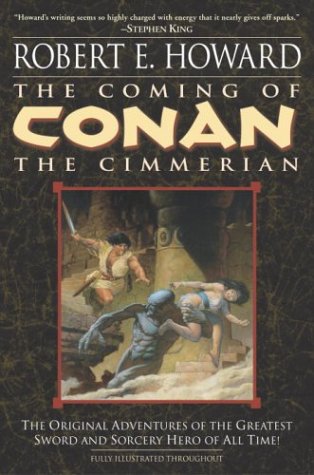New DaRK
5 Questions About: PornographyPoem: Sunrise Over Worcester
5 Questions About: Jason Pinter
12 Signs That You Might Be A Banker
The 9 Worst Movies to Win Oscars
Book Review: Narrow Miss for "Above the Law"
5 Questions About: Screaming Blue Messiahs
What's Up With All the Fat, Naked Guys?
Thoughts from the Shadows: The Craziness of Publis...
How to Make a Damn Good Horror Movie
Our Ongoing Features
5 Questions AboutLiterary Criticism
Fantastically Bad Cinema
Essays
Under God's Right Arm
Archive
May 2006June 2006
July 2006
August 2006
September 2006
October 2006
November 2006
December 2006
January 2007
February 2007
March 2007
April 2007
May 2007
June 2007
July 2007
August 2007
September 2007
October 2007
November 2007
December 2007
January 2008
February 2008
March 2008
April 2008
May 2008
June 2008
July 2008
August 2008
September 2008
October 2008
November 2008
December 2008
January 2009
February 2009
March 2009
Twitter
DaRK PaRTY NeTWORK
Arcanum CafeAlcoholic Poet
Baby Got Books
Beaman's World
BiblioAddict
Biblio Brat
Bill Crider's Pop Cultural Magazine
The Bleeding Tree
Blog Cabins: Movie Reviews
A Book Blogger's Diary
BookClover
Bookgasm
Bookgirl's Nightstand
Books I Done Read
Book Stack
The Book Trib
Cold Hard Football Facts
Creator of Circumstance
D-Movie Critic
The Dark Phantom Review
The Dark Sublime
Darque Reviews
Dave's Movie Reviews
Dane of War
David H. Schleicher
Devourer of Books
A Dribble of Ink
The Drunken Severed Head
Editorial Ass
Emerging Emma
Enter the Octopus
Fatally Yours
Flickhead
The Genre Files
The Gravel Pit
Gravetapping
Hello! Yoshi
HighTalk
Highway 62
The Horrors Of It All
In No Particular Order
It's A Blog Eat Blog World
Killer Kittens From Beyond the Grave
The Lair of the Evil DM
Loose Leafs From a Commonplace
Lost in the Frame
Little Black Duck
Madam Miaow Says
McSweeney's
Metaxucafe
Mike Snider on Poetry
The Millions
Moon in the Gutter
New Movie Cynics Reviews
Naked Without Books
A Newbie's Guide to Publishing
New & Improved Ed Gorman
9 to 5 Poet
No Smoking in the Skull Cave
Orpheus Sings the Guitar Electric
Polly Frost's Blog
Pop Sensation
Raincoaster
R.A. Salvatore
Reading is My Superpower
Richard Gibson
SciFi Chick
She Is Too Fond Of Books
The Short Review
Small Crimes
So Many Books
The Soulless Machine Review
Sunset Gun
That Shakesperherian Rag
Thorne's World
The Toasted Scrimitar
This Distracted Globe
Tomb It May Concern
2 Blowhards
Under God's Right Arm
A Variety of Words
The Vault of Horrr
Ward 6
When the Dead Walk the Earth
The World in the Satin Bag
Zoe's Fantasy
Zombo's Closet of Horror
Bookaholic Blogring
Power By Ringsurf
Saturday, November 29, 2008
Michael Connelly Book Winners Announced!
Did You Win "The Brass Verdict" and "The Lincoln Lawyer"?
 Michael Connelly is one of those crime writers that consistently hits doubles, triples, and homeruns. His Harry Bosch novels are among the best crime novels in the business. That's why he's won just about every crime writing prize there is to win, including the Edgar Award and the Shamus Award.
Michael Connelly is one of those crime writers that consistently hits doubles, triples, and homeruns. His Harry Bosch novels are among the best crime novels in the business. That's why he's won just about every crime writing prize there is to win, including the Edgar Award and the Shamus Award.We can honestly say that we've never finished one of Connelly's books and been disappointed. That's high praise for a popular mainstream novelist that seems to crank out two books every year. Not only are Connelly's books tightly plotted (with great surprise endings), but they're well-written and feature compelling characters.
Connelly has started a new series character, Mickey Haller, an attorney and a half-brother to Bosch. Hachette Books, Connelly's publisher, has asked DaRK PaRTY to help spread the word about Mickey Haller.
So we gave away "The Lincoln Lawyer" and the brand-new "The Brass Verdict" to a pair of lucky readers. The winners are:
- Scott from Foxboro, Massachusetts (Scott's favorite Connelly book is "Concrete Blond")
- John from Fairview Park, Ohio (John's favorite is "Lost Light")
There were more than a dozen entries -- and we thank everyone for entering. Stay tuned for more book giveaways this month.
Good luck and congratulations to Scott and John. Hachette Books will be mailing copies to you shortly.
Labels: books, Contest, Michael Connelly
 StumbleUpon |
StumbleUpon |
 del.icio.us |
del.icio.us |
 Technorati |
Technorati |
Wednesday, November 26, 2008
12 Signs That Your Wife Might Be a Superhero

1. Lifts the couch off the floor with one hand while vacuuming.
2. Shouts “Avengers Assemble” to get the kids upstairs at bedtime.
3. There’s a skin-tight cat suit in the back of her closet.
4. Some guy named Peter Parker keeps calling.
5. Strange packages from “Stark Industries.”
6. Won’t let you buy a Krypton lock for your bike.
7. Gets mad when you make disparaging remarks about mutants.
8. Likes bats.
9. She keeps saying: “Don’t make me angry. You won’t like me when I’m angry.”
10. Reads the “Daily Planet.”
11. Her “book group” members are Mister Fantastic, Thing, and Human Torch.
12. When you came home late from work last week, she grilled you about your whereabouts after tying you up with the “Lasso of Truth.”
12 Signs Your Boss Might Be a Zombie
Labels: 12 Signs, comics, Humor, superheroes
 StumbleUpon |
StumbleUpon |
 del.icio.us |
del.icio.us |
 Technorati |
Technorati |
Tuesday, November 25, 2008
Great Tunes: Jefferson Airplane's "White Rabbit"
It’s the scene from Hunter S. Thompson’s “Fear & Loathing in Las Vegas” (1972) that skyrocketed Jefferson Airplane’s “White Rabbit” to one of the greatest psychedelic rock songs ever recorded.
Thompson, tripping on a bad combination of LSD, cocaine, mescaline, and alcohol, stumbles into the torched hotel room of his attorney, Dr. Gonzo, who is submerged in a hot bath. He orders Thompson to throw his tape deck into the tub at the peak of “White Rabbit.”
“’White Rabbit.’ I need rising sound… And when it comes to that fantastic note where the rabbit bites its own head off, I want you to throw that fuckin’ radio into the tub with me!”
Thompson refuses, but Dr. Gonzo threatens to kill him if he doesn’t. So as lead singer Grace Slick and the Jefferson Airplane build “White Rabbit” to its crescendo and Dr. Gonzo screams for death by electrocution, Thompson throws a grapefruit in the water instead.
 Do bad drug trips get any more twisted than that?
Do bad drug trips get any more twisted than that?“White Rabbit” was first written in 1965 when Slick was the lead singer of The Great Society. The song was one of the reasons why Jefferson Airplane recruited her as its new lead singer to replace Signe Toly Anderson, who left the band after having her first child.
The song first appeared on vinyl in 1967 on Jefferson Airplane’s “Surrealistic Pillow” album. The song juxtaposes characters from Lewis Carroll’s children’s novel “Alice’s Adventures in Wonderland” (1865) with the hallucinatory experiences of an acid trip.
“White Rabbit” builds to a rising crescendo and adds elements of Spanish music, a snapping snare drum, and a driving electric guitar to create its own hallucinatory experience. It’s hard not to listen to “White Rabbit” and Grace’s trippy lyrics without a powerful urge to reach for the water bong.
Most of the lyrics get Carroll’s characters wrong (The White Knight, for example, does not talk backwards and the Dormouse never says “Feed your head”), but it doesn’t really matter. In fact, it adds another layer to the mystical feel of the number.
Because “White Rabbit” interpreted Carroll’s classic in a completely new way – infusing it with 1960s hippie messages and suddenly all of these innocent and vibrant characters have darker shades and that hookah-smoking caterpillar becomes damn suspicious. Because he is smoking from a hookah and sitting on a fucking mushroom.
Then there is Slick herself. She looks like a college honor student with her puppy dog eyes and librarian good looks (she was a model before she was a singer). But underneath those American girl looks was a rebel -- a free spirit. You didn't know what Slick would do next. Hell, she wanted to spike U.S. President Richard Nixon's tea with LSD. She brings that shimmering tension to the vocals of "White Rabbit."
The song has had incredible influence and according to the music site All Music, “White Rabbit” has been covered by more than 100 bands, including the gothic punk band the Damned and jazz musician George Benson.
 But the song has had more than just musical influence – it’s a full-blown cultural phenomenon. Listening to “White Rabbit” is like stepping into a time machine back to the 1960s and stirs up striking visuals of the time: Woodstock, round sunglasses, hippies without shirts, headbands, and mood rings.
But the song has had more than just musical influence – it’s a full-blown cultural phenomenon. Listening to “White Rabbit” is like stepping into a time machine back to the 1960s and stirs up striking visuals of the time: Woodstock, round sunglasses, hippies without shirts, headbands, and mood rings.“White Rabbit” has been featured on the Simpsons – three times. It was featured in Oliver Stones’ “Platoon” and been written about by Stephen King. Blue Man Group has done a cover. It inspired the book “Go Ask Alice.” It’s in video games and was played on “The Sopranos.” It’s everywhere.
What do you think Morpheus was referring to when he said to Neo in “The Matrix”: “You take the blue pill - the story ends, you wake up in your bed and believe whatever you want to believe. You take the red pill - you stay in Wonderland and I show you how deep the rabbit-hole goes”? It certainly wasn’t Lewis Carroll.
Morpheus is talking about “White Rabbit.”
The Lyrics:
One pill makes you larger
And one pill makes you small
And the ones that mother gives you
Don't do anything at all
Go ask Alice
When she's ten feet tall
And if you go chasing rabbits
And you know you're going to fall
Tell them a hookah smoking caterpillar
Has given you the call
Recall Alice
When she was just small
When men on the chessboard
Get up and tell you where to go
And you've just had some kind of mushroom
And your mind is moving slow
Go ask Alice
I think she'll know
When logic and proportion
Have fallen sloppy dead
And the White Knight is talking backwards
And the Red Queen's "off with her head!"
Remember what the dormouse said;
"Feed your head!
“Feed your head!”
Good Songs From Really Awful Bands
Overlooked Albums From Really Good Bands
Highway to Hell: The 10 Greatest AC/DC Songs
Labels: Great Tunes, Jefferson Airplane, Music, Music Review, Songs, White Rabbit
 StumbleUpon |
StumbleUpon |
 del.icio.us |
del.icio.us |
 Technorati |
Technorati |
Monday, November 24, 2008
Thanksgiving Movies Rejected by Hollywood
Why Does Hollywood Refuse to Give Thanksgiving Any Love? Here's Why!

Thanksgiving gets no respect from Hollywood. Halloween, Christmas, and even April Fools Day have gotten movies dedicated to them. But Thanksgiving? Other than "Home for the Holidays" and "Planes, Trains and Automobiles," this most American holiday has been ignored.
DaRK PaRTY, however, was able to get our turkey-greased fingers on a few Thanksgiving motion pictures that were rejected by Hollywood. They seem like perfectly good movies to us. But you decide:
Fangsgiving Day
Beautiful high school senior Sarah (Vanessa Hudgens from “High School Musical 3”) and her dysfunctional family travel to rural Wisconsin for Thanksgiving with their estranged aunt. Once they arrive at the farming outpost, Sarah meets a charming young man named Clive (Shia LaBeouf) at the local 4-H club. The two teenagers fall instantly in love while judging an apple pie baking contest together. There’s only one problem – Clive is a vampire! Clive doesn’t feed on humans, however, but on the blood of turkeys at a large processing plant in town. Can Clive use his centuries of wisdom to help Sarah mend the petty disagreements and old resentments in her family before an evil vampire hunter (a very creepy performance by Robert De Niro) finds Clive? And will Sarah and Clive find true love despite their differences? Find out on Fangsgiving Day!
My Blood-Drenched Thanksgiving
More than 10 years ago in Turkey Cove, a small coastal town in Maine, an animal rights activist went crazy and killed three families who refused to have vegan celebrations on Thanksgiving Day. The killer (played by Robert Pattinson of “Twilight”) has now escaped from a mental institution and is on his way back to his hometown for revenge. His target is Ray Davidson (Thomas Haden Church), the owner of the Turkey Cove Super Saver, the supermarket that supplies the village with their Thanksgiving Day birds. Meanwhile Davidson had invited his extended family to his seaside manor for his annual Thanksgiving Day feast. Among the guests is his pretty teenage daughter Bella (Hayden Panettierre of “Heroes”). As members of Bella’s extended family begin to get hacked apart with an electric carving knife and have their mouths crammed with stuffing, the resourceful high schooler tries to elude the killer and save her immediate family from the same fate.
The Homecoming Game
The 1988 Pittsboro High School football team lost the Thanksgiving Day game against rival Sterling High School despite being heavily favored to win. The loss kept the team out of the state championship and started an extended 20-year losing streak against Sterling. Still unable to cope with the disappointment, former star quarterback Brett (Owen Wilson), now a two-bit loser, organizes a rematch for charity. He enlists his former teammates – star wide receiver (Will Ferrell), now a famous Hollywood actor, and star running back (Vince Vaughn), a homeless drunk, to help in the effort. The problem? The star Sterling quarterback, the obnoxious Jerry (Ben Stiller), is Brett’s boss at the Sterling Used Car Emporium. Can Brett keep his job and beat his boss on the playing field when the two teams – now made up of grumpy middle-aged men – meet for a Thanksgiving Day rematch? And will Brett finally be able to finally win back his high school sweetheart Emma (played by Reese Witherspoon)?
The Gobbler
Jimmy Gullet (voiced by Jack Black) is a turkey raised on one of the largest turkey farms in the country. It’s wonderful home for 364 days of the year anyway! A week before Thanksgiving, Jimmy accidentally overhears the cunning Farmer Blade (voiced by Dustin Hoffman) reveal the fate of Jimmy and thousands of his friends and family – Thanksgiving Day dinners! Jimmy has a week to save everyone at the farm from the axe! Can Jimmy convince his friends Jumpy the Squirrel (Whoopie Goldberg) and Ernie the Cow (John Ratzenberger) to help him organize his fellow turkeys to revolt and takeover the farm from Farmer Blade and his evil minions before the slaughter begins? Or will Jimmy have to take the axe to the farmer himself?
The Case of the Flying Mechanic
Thor: Sex Advice Columnist
12 Valuable Lessons from Hollywood
 StumbleUpon |
StumbleUpon |
 del.icio.us |
del.icio.us |
 Technorati |
Technorati |
Friday, November 21, 2008
Gods of Death
Death is ever enticing – a luring beacon that finally consumes us all. It’s the inevitable fate of every living creature. Death even takes entire civilizations (Rome and Maya for example). It is the destination we all reach. The finish line for all of us is rot, decay, and a return to dirt.
Yet most modern Western cultures have become quite adept at ignoring or avoiding any discussion about death. Ever try to bring death up at a cocktail party? There won’t be many takers.
The enormity of our mortality has spawned centuries of mythology around death. Most cultures from Greeks to the Aztecs have developed narratives and destinations for the lost souls – and the immortal caretakers who will greet us there.
Western civilization has given us Christianity – where we are guided to heaven’s door by angels and even saints. There, of course, we’ll find lots of bright golden light, fluffy clouds, and the throne of God and Jesus. We also have concocted the dreaded Grim Reaper, a scathe-welding figure in a dark cowl that visits us on our deathbeds.
DaRK PaRTY has collected some of the more interesting Gods of Death that ancient civilizations have bestowed upon us. When you come to the end of the line perhaps you’ll be greeted by one of them.
 Hades
Hades
Origin: Greek Mythology
Title: God of the Underworld
Also Known As: The Unseen One, The Rich One, The Silent One (the Romans later adopted Hades, but renamed him as Pluto)
Symbols: Helm of Darkness (which makes him invisible)
Known Associates: Parents Cronuss and Rhea, brothers Zeus and Poseidon, sisters Demeter, Hestia, and Hera. Married to Persephone. Pet: Cerberus, the three-headed dog
Residence: The underworld, also known as Hades. A foggy, gloomy abode for the dead
Description: Despite being feared by mortals (priests averted their eyes when making sacrifices of black sheep to him), Hades was a rather passive ruler with a goal of maintaining a strict division between the living and the dead. He forbade the dead from leaving his kingdom and would become enraged if they tried to escape. His personality was rather dark and melancholy and he was not very popular among his peers. He spent most of his time in Hades ensconced on his ebony throne rather than cavorting with his fellow gods on Mount Olympus
Influence Today: Hell is often referred to as Hades in Christian mythology
 Dis Pater
Dis Pater
Origin: Celtic Mythology
Title: God of the Underworld
Also Known As: Dis, Father of Riches
Symbols: Precious gems
Known Associates: Aerucra, the Celtic earth goddess, was his consort
Residence: The underworld
Description: Little is known about Dis Pater, but it is believed that he was once a god of wealth, but eventually became associated with death because gems and precious metals were found in the earth. When the Celts and the Gauls were defeated by the Romans and integrated into Roman culture, Dis Pater morphed into Pluto, the Roman god of death
Influence Today: A Russian goth rock metal band is called Dis Pater and the Dispater also appears as a deity in fantasy role-playing game Advanced Dungeons & Dragons
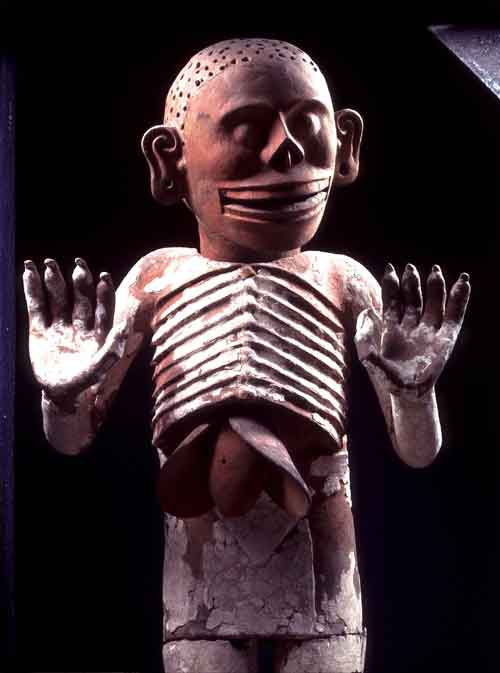 Mictlantecuhtli
Mictlantecuhtli
Origin: Aztec Mythology
Title: God of the Dead and King of Mictlan (the lowest level of the Aztec underworld)
Also Known As: Lord of Mictlan
Symbols: A blood-splattered skeleton, a toothy skull, spiders, owls, bats
Known Associates: His wife Mictecacihuatl and bats, owls, and spiders
Residence: A windowless castle on the 9th and lowest level of the Aztec underworld
Description: The most powerful of several Aztec gods and goddess of death. Priest who worshipped him sometime ate human flesh. He is most often presented as a blood-soaked skeleton, but to Aztecs the skeleton was a symbol of fertility and abundance
Influence Today: The Aztec gods are mostly forgotten, but there was a comic dedicated to Mictlantecutli and a heavy metal band from L.A. bears his name
 Morrigan
Morrigan
Origin: Irish Mythology
Title: Phantom Queen, Great Queen
Also Known As: Morrigu, Morrighan, Mor-Rioghain
Symbols: A crow, especially those crows that eat the dead after a battle. Also depicted as an eel, wolf, and a cow
Known Associates: Badb, the goddess of war, and Macha, a goddess of sovereignty
Residence: The Irish countryside
Description: She is often depicted a goddess associated with the violent death of warriors – sometimes interchangeable with her sisters Babd and Macha. She appears as a crow and various animals, but can also appears as an old hag
Influence Today: Another forgotten old god, but a German black metal band bears her name and she appears as a character in the video game series Capcom
 Anubis
Anubis
Origin: Egyptian Mythology
Title: God of the Underworld
Also Known As: He who is upon his mountain, He who is in the place of embalming, Guardian of the Veil Symbols: The color black, the flail, nine bows, and jackals
Known Associates: Son of Set, the Evil One, and married to Nephthys (also his sister)
Residence: The Realm of the Dead
Description: Most often portrayed as a black man with the head of a jackal and carrying a flail. Anubis is associated with rotting bodies and scavengers that ate the flesh of the dead. He was also associated with the embalming of mummies. He was in charge of admission to the Egyptian Realm of the Dead. Later, Anubis was downgraded to a minor god (losing out to the more popular Osiris)
Influence Today: Anubis is often portrayed in comics and video games. He’s also been a character of fantasy TV shows such as BeastMaster and Stargate. Anubis also appears in Neil Gaiman’s novel “American Gods”
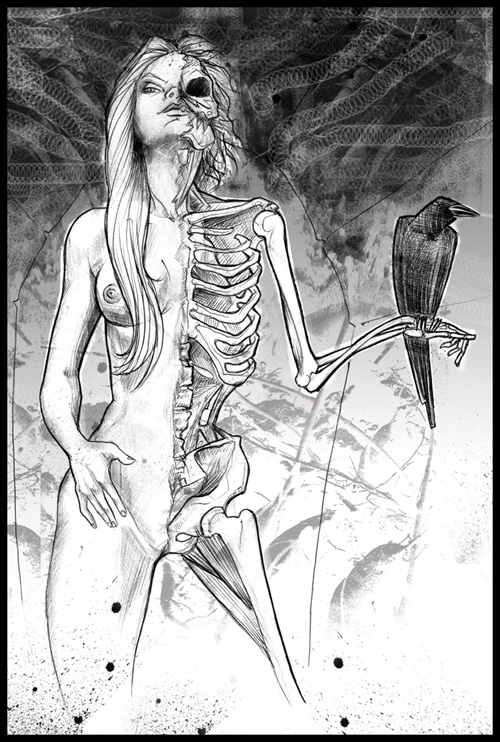 Hel
Hel
Origin: Norse/Finnish Mythology
Title: Goddess of Hel
Also Known As: N/A
Symbols: She carries a dish called “Hunger” and a dagger called “Famine.”
Known Associates: Daughter of Loki. Her serving maid is Ganglot
Residence: Enormous estates called the “Halls of Hel” in a section of Niflheim (the mist world)
Description: She appears as a woman with half her skin black and the other half white. She is a gloomy, frowning woman. She is often associated with those who die from sickness or old age
Influence Today: Hel is a god in Advanced Dungeons & Dragons, but remains nearly forgotten
 Yama
Yama
Origin: Chinese Mythology
Title: Lord of Death
Also Known As: Yamaraja, Yanluowang or Yan
Symbols: N/A
Known Associates: His father Surya and his twin sister Yami. His commander is Lord Shiva, the Destroyer
Residence: The world of the dead and Hell
Description: Yama is portrayed with green or red skin and usually riding a water buffalo. He uses a rope to pull the souls of the dead from their bodies. He is considered the first mortal who died and then become the god and guardian of the underworld
Influence Today: N/A
 Veles
Veles
Origin: Slavic Mythology
Title: God of the Underworld
Also Known As: Cryrillic and Volos
Symbols: Associated with dragons and cattle.
Known Associates: Enemy of the thunder god Perun
Residence: Slavs considered the world a giant tree. The branches were heaven and the roots the underworld. Veles, in the form of a serpent, lived coiled around the roots in underground caves and passages. Here he ruled over the dead.
Description: Often depicted as a snake or a dragon with the horns of a ram and having a long beard. He often sent heralds to the land of the living. He was worshipped at the beginning of winter when Slavs thought the border between life and death faded
Influence Today: N/A
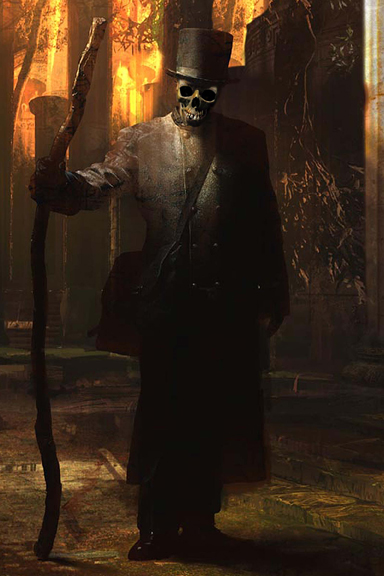 Baron Samedi
Baron Samedi
Origin: Voodoo Mythology
Title: Loa of the Dead
Also Known As: Baron Samdi, Bawon Samedi or Baron Saturday
Symbols: Phallic symbols
Known Associates: His wife is Maman Brigitte
Residence: At the crossroads of where dead spirits journey to Guinee, the land of the dead
Description: Depicted with a white top hat and wearing a black tuxedo. He wears dark glasses over his white, skull-like face. He is fond of disruption, obscenity, debauchery, and his known to enjoy rum and tobacco
Influence Today: He was a villain in the James Bond film “Live and Let Die.” A British rapper goes by the same name and he’s been featured as a character in Marvel Comics as a villain of Doctor Strange.
Leinth
Origin: Etruscan Mythology (northern Italy)
Title: Goddess of Death
Also Known As: Old Age, Old Woman, and She Who Stops
Symbols: N/A
Known Associates: Laran, god of war, Selvens, civil god, and Turan, the goddess of love
Residence: At the gates of death where she led the dead souls into the Underworld
Description: A woman with a veiled face. She is thought to be very gloomy and depressing
Influence Today: N/A
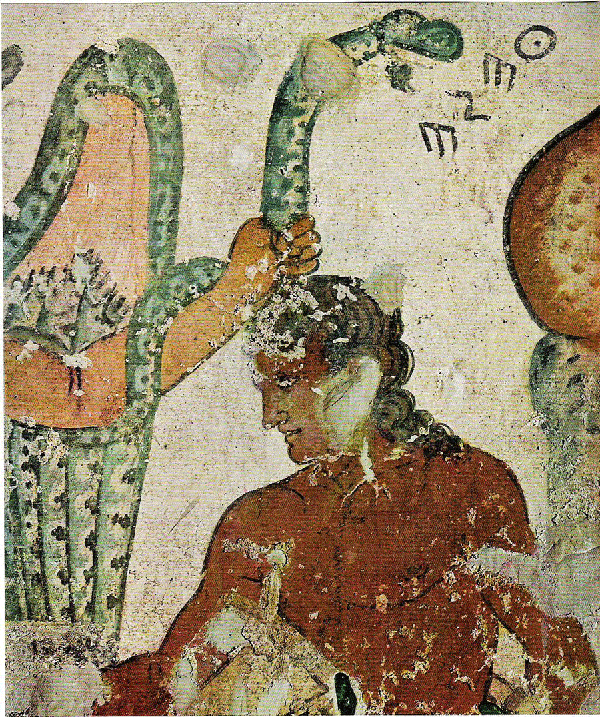 Orcus
Orcus
Origin: Gaul Mythology (later Roman)
Title: God the Underworld and Punisher of Broken Oaths
Also Known As: Later transformed into/associated with Pluto, Hades, and Dis Pater
Symbols: N/A
Known Associates: He is associated with demons, monsters, and giants
Residence: Lived in the land of the dead
Description: A gnarled, hairy giant with a beard (may have been a Cyclops). He was considered a punishing and evil god
Influence Today: Orcus appears in several role-playing games as a demon prince and god of the undead, including Advanced Dungeons & Dragons, NetHack, and Empire of the East. He has appeared in comic strips as well.
A Question of God
The Death of Poetry
Mike Snider's poem "In the Dark Woods"
 StumbleUpon |
StumbleUpon |
 Digg |
Digg |
 del.icio.us |
del.icio.us |
 Reddit |
Reddit |
 Technorati |
Technorati |
 E-mail
E-mail

Yet most modern Western cultures have become quite adept at ignoring or avoiding any discussion about death. Ever try to bring death up at a cocktail party? There won’t be many takers.
The enormity of our mortality has spawned centuries of mythology around death. Most cultures from Greeks to the Aztecs have developed narratives and destinations for the lost souls – and the immortal caretakers who will greet us there.
Western civilization has given us Christianity – where we are guided to heaven’s door by angels and even saints. There, of course, we’ll find lots of bright golden light, fluffy clouds, and the throne of God and Jesus. We also have concocted the dreaded Grim Reaper, a scathe-welding figure in a dark cowl that visits us on our deathbeds.
DaRK PaRTY has collected some of the more interesting Gods of Death that ancient civilizations have bestowed upon us. When you come to the end of the line perhaps you’ll be greeted by one of them.
 Hades
HadesOrigin: Greek Mythology
Title: God of the Underworld
Also Known As: The Unseen One, The Rich One, The Silent One (the Romans later adopted Hades, but renamed him as Pluto)
Symbols: Helm of Darkness (which makes him invisible)
Known Associates: Parents Cronuss and Rhea, brothers Zeus and Poseidon, sisters Demeter, Hestia, and Hera. Married to Persephone. Pet: Cerberus, the three-headed dog
Residence: The underworld, also known as Hades. A foggy, gloomy abode for the dead
Description: Despite being feared by mortals (priests averted their eyes when making sacrifices of black sheep to him), Hades was a rather passive ruler with a goal of maintaining a strict division between the living and the dead. He forbade the dead from leaving his kingdom and would become enraged if they tried to escape. His personality was rather dark and melancholy and he was not very popular among his peers. He spent most of his time in Hades ensconced on his ebony throne rather than cavorting with his fellow gods on Mount Olympus
Influence Today: Hell is often referred to as Hades in Christian mythology
 Dis Pater
Dis PaterOrigin: Celtic Mythology
Title: God of the Underworld
Also Known As: Dis, Father of Riches
Symbols: Precious gems
Known Associates: Aerucra, the Celtic earth goddess, was his consort
Residence: The underworld
Description: Little is known about Dis Pater, but it is believed that he was once a god of wealth, but eventually became associated with death because gems and precious metals were found in the earth. When the Celts and the Gauls were defeated by the Romans and integrated into Roman culture, Dis Pater morphed into Pluto, the Roman god of death
Influence Today: A Russian goth rock metal band is called Dis Pater and the Dispater also appears as a deity in fantasy role-playing game Advanced Dungeons & Dragons
 Mictlantecuhtli
MictlantecuhtliOrigin: Aztec Mythology
Title: God of the Dead and King of Mictlan (the lowest level of the Aztec underworld)
Also Known As: Lord of Mictlan
Symbols: A blood-splattered skeleton, a toothy skull, spiders, owls, bats
Known Associates: His wife Mictecacihuatl and bats, owls, and spiders
Residence: A windowless castle on the 9th and lowest level of the Aztec underworld
Description: The most powerful of several Aztec gods and goddess of death. Priest who worshipped him sometime ate human flesh. He is most often presented as a blood-soaked skeleton, but to Aztecs the skeleton was a symbol of fertility and abundance
Influence Today: The Aztec gods are mostly forgotten, but there was a comic dedicated to Mictlantecutli and a heavy metal band from L.A. bears his name
 Morrigan
MorriganOrigin: Irish Mythology
Title: Phantom Queen, Great Queen
Also Known As: Morrigu, Morrighan, Mor-Rioghain
Symbols: A crow, especially those crows that eat the dead after a battle. Also depicted as an eel, wolf, and a cow
Known Associates: Badb, the goddess of war, and Macha, a goddess of sovereignty
Residence: The Irish countryside
Description: She is often depicted a goddess associated with the violent death of warriors – sometimes interchangeable with her sisters Babd and Macha. She appears as a crow and various animals, but can also appears as an old hag
Influence Today: Another forgotten old god, but a German black metal band bears her name and she appears as a character in the video game series Capcom
 Anubis
AnubisOrigin: Egyptian Mythology
Title: God of the Underworld
Also Known As: He who is upon his mountain, He who is in the place of embalming, Guardian of the Veil Symbols: The color black, the flail, nine bows, and jackals
Known Associates: Son of Set, the Evil One, and married to Nephthys (also his sister)
Residence: The Realm of the Dead
Description: Most often portrayed as a black man with the head of a jackal and carrying a flail. Anubis is associated with rotting bodies and scavengers that ate the flesh of the dead. He was also associated with the embalming of mummies. He was in charge of admission to the Egyptian Realm of the Dead. Later, Anubis was downgraded to a minor god (losing out to the more popular Osiris)
Influence Today: Anubis is often portrayed in comics and video games. He’s also been a character of fantasy TV shows such as BeastMaster and Stargate. Anubis also appears in Neil Gaiman’s novel “American Gods”
 Hel
HelOrigin: Norse/Finnish Mythology
Title: Goddess of Hel
Also Known As: N/A
Symbols: She carries a dish called “Hunger” and a dagger called “Famine.”
Known Associates: Daughter of Loki. Her serving maid is Ganglot
Residence: Enormous estates called the “Halls of Hel” in a section of Niflheim (the mist world)
Description: She appears as a woman with half her skin black and the other half white. She is a gloomy, frowning woman. She is often associated with those who die from sickness or old age
Influence Today: Hel is a god in Advanced Dungeons & Dragons, but remains nearly forgotten
 Yama
YamaOrigin: Chinese Mythology
Title: Lord of Death
Also Known As: Yamaraja, Yanluowang or Yan
Symbols: N/A
Known Associates: His father Surya and his twin sister Yami. His commander is Lord Shiva, the Destroyer
Residence: The world of the dead and Hell
Description: Yama is portrayed with green or red skin and usually riding a water buffalo. He uses a rope to pull the souls of the dead from their bodies. He is considered the first mortal who died and then become the god and guardian of the underworld
Influence Today: N/A
 Veles
VelesOrigin: Slavic Mythology
Title: God of the Underworld
Also Known As: Cryrillic and Volos
Symbols: Associated with dragons and cattle.
Known Associates: Enemy of the thunder god Perun
Residence: Slavs considered the world a giant tree. The branches were heaven and the roots the underworld. Veles, in the form of a serpent, lived coiled around the roots in underground caves and passages. Here he ruled over the dead.
Description: Often depicted as a snake or a dragon with the horns of a ram and having a long beard. He often sent heralds to the land of the living. He was worshipped at the beginning of winter when Slavs thought the border between life and death faded
Influence Today: N/A
 Baron Samedi
Baron SamediOrigin: Voodoo Mythology
Title: Loa of the Dead
Also Known As: Baron Samdi, Bawon Samedi or Baron Saturday
Symbols: Phallic symbols
Known Associates: His wife is Maman Brigitte
Residence: At the crossroads of where dead spirits journey to Guinee, the land of the dead
Description: Depicted with a white top hat and wearing a black tuxedo. He wears dark glasses over his white, skull-like face. He is fond of disruption, obscenity, debauchery, and his known to enjoy rum and tobacco
Influence Today: He was a villain in the James Bond film “Live and Let Die.” A British rapper goes by the same name and he’s been featured as a character in Marvel Comics as a villain of Doctor Strange.
Leinth
Origin: Etruscan Mythology (northern Italy)
Title: Goddess of Death
Also Known As: Old Age, Old Woman, and She Who Stops
Symbols: N/A
Known Associates: Laran, god of war, Selvens, civil god, and Turan, the goddess of love
Residence: At the gates of death where she led the dead souls into the Underworld
Description: A woman with a veiled face. She is thought to be very gloomy and depressing
Influence Today: N/A
 Orcus
OrcusOrigin: Gaul Mythology (later Roman)
Title: God the Underworld and Punisher of Broken Oaths
Also Known As: Later transformed into/associated with Pluto, Hades, and Dis Pater
Symbols: N/A
Known Associates: He is associated with demons, monsters, and giants
Residence: Lived in the land of the dead
Description: A gnarled, hairy giant with a beard (may have been a Cyclops). He was considered a punishing and evil god
Influence Today: Orcus appears in several role-playing games as a demon prince and god of the undead, including Advanced Dungeons & Dragons, NetHack, and Empire of the East. He has appeared in comic strips as well.
A Question of God
The Death of Poetry
Mike Snider's poem "In the Dark Woods"
Labels: Ancient gods, death
 StumbleUpon |
StumbleUpon |
 del.icio.us |
del.icio.us |
 Technorati |
Technorati |
Thursday, November 20, 2008
5 Questions About: Stephen Crane
An Interview with the Past President of The Stephen Crane Society
(DaRK PaRTY has been on a Stephen Crane kick. We recently reread "The Red Badge of Courage" and picked up a volume of Crane's short stories. Crane may be one of the most ignored major American writers. He certainly doesn't have the recognition that Hemingway, Faulkner, Fitzgerald, Twain or that rascal Poe have garnered. Yet Crane's prose (and even his poetry) influenced the great writers that came after him. Hemingway was an enormous advocate of Crane's high status among the literary elite of American letters. We decided -- as we are oft to do -- to discover more about Crane. So we reached out to Donna Campbell, a professor of literature at Washington State University and a past president of the Stephen Crane Society. Donna agreed to field our questions about this mythic writer who died at age 28 from a massive hemorrhage in his lungs.)
 DaRK PaRTY: Despite his influence on writers like Hemingway, Stephen Crane is often one of the forgotten American writers. How important was Crane to American literature?
DaRK PaRTY: Despite his influence on writers like Hemingway, Stephen Crane is often one of the forgotten American writers. How important was Crane to American literature?Donna: Crane was and is very important to American literature; as you mention, he influenced Hemingway, something Hemingway acknowledged in his discussion of American authors in “The Green Hills of Africa.” His distinctive style, which James Nagel and others have called “literary impressionism,” made him memorable (and frequently parodied) in his own time, and it paves the way for later authors. In his novels and short stories, Crane combines the ability to describe the interior motivations and psychological states of characters, something more commonly attributed to Henry James, with the ability to describe human beings in settings of adventure or danger, whether those consist of battlegrounds or the slums of New York.
DP: What do you believe is the biggest misunderstanding about Crane and his writing?
Donna: Perhaps the biggest misunderstanding is that people believe Crane wrote about war and nothing else. While he did write about war, most notably in “The Red Badge of Courage” and his stories about the Spanish-American War and the Greco-Turkish war, Crane also wrote about his travels in the West and in England and Ireland. He also wrote fine stories about small-town America, slum tales like “Maggie: A Girl of the Streets,” romantic idylls like “The Third Violet,” and two volumes of poetry.
DP: What makes "Red Badge of Courage" an important novel?
Donna: “The Red Badge of Courage” is considered Crane’s masterpiece because of its psychological depth of insight into an experience that is both uniquely American (the Civil War) and universal (the experience of an untested young man experiencing battle for the first time). Crane’s handling of the material is distinctive; he represents war from the perspective of the common man rather than the generals, and he focuses on the lived experience of soldiers—fear, boredom, and heroism—rather than on the tactics and outcomes of battles.
DP: What do you think is Crane's best short story and why?
 Donna: “The Open Boat” is probably Crane’s best story, since it illustrates the elements that make his fiction great: the representation of men in extreme circumstances, told with great insight into the psychology of those involved, in a style and structure that heightens the effect of the story through description, symbolism, and the elimination of any unnecessary element. In “The Open Boat,” Crane manages to convey his philosophy of an indifferent universe, but the story also highlights the ways in which individuals grapple with this idea yet manage to find a kind of brotherhood. Crane wrote many great stories, however, among them “The Blue Hotel”; a longer story or novella that deserves to be read more frequently is “The Monster.”
Donna: “The Open Boat” is probably Crane’s best story, since it illustrates the elements that make his fiction great: the representation of men in extreme circumstances, told with great insight into the psychology of those involved, in a style and structure that heightens the effect of the story through description, symbolism, and the elimination of any unnecessary element. In “The Open Boat,” Crane manages to convey his philosophy of an indifferent universe, but the story also highlights the ways in which individuals grapple with this idea yet manage to find a kind of brotherhood. Crane wrote many great stories, however, among them “The Blue Hotel”; a longer story or novella that deserves to be read more frequently is “The Monster.”DP: Would you describe Crane's death at the age of 29 a literary tragedy?
Donna: Yes, in all probability. There is no way to judge what Crane might have written next, for near the time of his death, he was writing in part for money to keep his household going.
Stephen Crane at Amazon.com
Read our 5 Questions Interviews about other great writers:
Jane Austen
Ambrose Bierce
Charles Bukowski
(Photos courtesy of Washington State University and the Stephen Crane Society)
Labels: 5 Questions, Donna Campbell, interview, literature, Stephen Crane
 StumbleUpon |
StumbleUpon |
 del.icio.us |
del.icio.us |
 Technorati |
Technorati |
Tuesday, November 18, 2008
Nosferatu
The 86-year-old Vampire Film Needs a Careful Watching to Appreciate
Ironically, for a film that is 86 years old, “Nosferatu” starts off, like a bad, self-produced YouTube video.
Thankfully, it improves.
I’ve always wanted to watch the first vampire movie ever made and the one that is often considered the greatest adaptation of Bram Stoker’s “Dracula.” It’s an unofficial version and Stoker’s estate actually sued German Director F.W. Murnau over it. All copies of the film were ordered destroyed.
 Obviously, it survived.
Obviously, it survived.Murnau, who died in a car crash at age 43, didn’t even try very hard to disguise the movie: naming Harker Huffer and Count Dracula Count Orlok, leaving little doubt about the source material.
It’s difficult for a generation weaned on special effects, surround sound, and the miracle of HD-TV to really appreciate “Nosferatu” (1922) without boredom setting in (even at a short 80 minutes). The pacing is arduous and editing reflects the limited technologies of the day.
“Nosferatu” is black-and-white (and most versions, including the one I watched, are scratchy and a bit faded on the edges). It’s also a silent film, the narrative constantly interrupted by written dialog boxes.
There’s also a lot of overacting employed by actors of the day (after all they needed to convey in action what is now done through speech). But to modern audiences the exaggerated facial expressions get tiresome rather quickly.
Yet if you settle into the right frame of mind – there’s a lot to admire in “Nosferatu.” The highlight is actor Max Schreck as Count Graf Orlok. He’s simply repulsive. Unlike the modern versions of vampires as charming seducers, Schreck’s Orlok is a monstrosity. He’s a hideous skeletal being with long bony fingers, ears like a bat, and fangs that look like they belong on an oversized rodent. There’s nothing enchanting about him.
He’s creepy. Very creepy. The famous shot of him rising up out of coffin – filled with soil from the graveyard of Black Death victims – his body stiff and straight – and it’s easy to understand why the film has lasted more than eight decades.
Murnau accomplished a lot with his limited resources. He expertly uses light and shadow. In fact, Schreck’s shadow could be considered another character in the film. And there are marvelous symbols scattered throughout the film: from a skeleton clock to the Venus Fly trap eating a bug. Murnau is able to cobble together a compelling narrative with few dialog cards, allowing, for the most part, the action to unfold.

But like any horror movie, the real question is: Is “Nosferatu” scary?
The answer, unfortunately, is: hardly.
By today’s standards, the film would have a difficult time scaring a five year old. It has eerie moments – and Schreck is in most of them – but it’s a tame ride for anyone who has watched John Carpenter’s “Halloween” or Stanley Kubrick’s “The Shining.” Amazingly, the film was banned for “excessive horror” in Sweden until 1972.
“Nosferatu” remains an oddity, a film any serious horror aficionado should watch in order to understand the origins of the genre. The film’s greatest impact may have been in bringing the world the concept of sunlight killing vampires. “Nosferatu” is the source material for that bit of legend.
Watch it, but don’t expect too much. The hype and the legend around “Nosferatu” are much better than the actual film.
7 Scary Water Movies
Ode to "Dawn of the Dead"
5 Questions About: Dracula
Labels: Horror, Movie Review, Nosferatu, Vampire
 StumbleUpon |
StumbleUpon |
 del.icio.us |
del.icio.us |
 Technorati |
Technorati |
Monday, November 17, 2008
Book Review: "The Guards" Scary Good
Ken Bruen's Jack Taylor Debut Packs Many Surprises
“The Guards” (2001) is a genre mystery in much the same way that “Moby-Dick” is a book about whale hunting.
 That’s about as far as I’ll go comparing the monstrous, densely written classic by Herman Melville and the Spartan poetic prose of Ken Bruen.
That’s about as far as I’ll go comparing the monstrous, densely written classic by Herman Melville and the Spartan poetic prose of Ken Bruen.On the surface, there’s no reason why “The Guards” should work. The novel introduces us to Jack Taylor, who has become Bruen’s series character (now appearing in seven novels). Taylor is a collection of clichés: an ex-cop, a drunk, a hard case, a loner, and a closet bibliophile who reads poetry.
Haven’t we seen this character before? Yes, over and over and over again.
There’s even a scene in “The Guards” where Taylor is brutally pounded on by two burly cops (known as guards in Ireland) and ends up in the hospital. Waking up, and still severely injured, Taylor puts on his clothing and storms out. No hospitals for him!
Yet, Jack Taylor comes across and nothing short of authentic. Bruen skirts over the clichés – seemingly mocking them from the sidelines – and gives us a protagonist that rages against the dying of the light. A character that strides through the pages of “The Guards” like the reincarnation Dashiell Hammett’s Continental Op, but wearing a leprechaun hat.
Like Hammett’s amoral private detective, Jack Taylor has witnessed so much murder and misery that his sense of compassion, his humanity, has been worn down to a nub. Taylor skates along the edge of right and wrong – not quite sure where the boundaries are anymore.
And it works. Jack Taylor lives and breathes. As a reader, you believe in him.
Then there’s the plot – which is a mess for a genre mystery. Allegedly, Taylor is hired by a widow to investigate the alleged suicide of her teenage daughter. Yet, Taylor barely musters up the resolve to mount even a minimal investigation (hey, it might get in the way of his next bender).
But in the end – who cares? The plot is beside the point. The real star of “The Guards” is Bruen’s writing: elegant, stark, brutal, comic, and drenched with emotion. This is hardboiled crime fiction that could make James Joyce stab someone in the eye with a broken whiskey bottle.
And let’s not forget the setting: the coastal Irish city of Galway. Bruen nails it. He gives us Galway: the city streets, the old hotels, the ancient barrooms, the cemeteries, and the undercurrent of Catholicism, and, of course, the dialog. It sings.
There’s a certain satisfaction as a reader discovering your next novelist. Knowing that you’ve found a writer that you’re going to be spending a lot of time with – because you’re going to read everything he’s written. For me, right now, this is Bruen.
Read “The Guards.”
That’s really all that needs to be said.
Read “The Guards.”
5 Questions About: Chick Lit
The World's Scariest Short Story?
Thor: Home Improvement Columnist
Labels: book review, Ken Bruen, literature, The Guards
 StumbleUpon |
StumbleUpon |
 del.icio.us |
del.icio.us |
 Technorati |
Technorati |
Sunday, November 16, 2008
12 Signs That Your Boss Might Be A Zombie
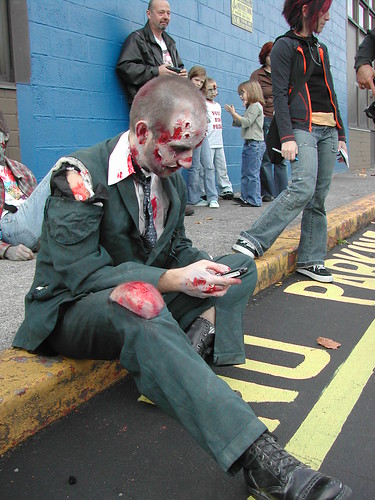
1. The holiday bonus this year is a severed human hand and an accompanying recipe book.
2. His Right Guard deodorant can’t disguise the smell of the grave.
3. She doesn’t blink.
4. Accidentally devoured the business consultant from IBM.
5. During the last staff meeting, her leg fell off.
6. Listed his race in tax documents as “Reanimated Human Corpse-American.”
7. At lunch, he ordered a raw human brain.
8. What’s with the shambling gait and all the moaning?
9. Keeps biting the administrative assistant.
10. Gets choked up when discussing George A. Romero.
11. Adamant that there’s no such thing as a “Zombie Plague.”
12. Insists on being called ZEO.
5 Questions About: Thrillers (an interview with novelist Michael Marshall Smith)
Essay: We All Die
Flame-Outs: 5 Bands That Should Have Been Huge -- But Blew It
Labels: 12 Signs, Horror, Humor, Zombies
 StumbleUpon |
StumbleUpon |
 del.icio.us |
del.icio.us |
 Technorati |
Technorati |
Friday, November 14, 2008
Good Songs, Really Bad Bands
10 Rock Classics Sung by Downright Awful Musicians
The cliché is: “Even a broken clock is right twice a day.” And to stretch the metaphor to its utmost limits – even crappy bands and musicians hit pay dirt. DaRK PaRTY has collected a list of 10 major league great tunes sung by downright awful bands. Feel free to add your own addition to the list in our comments section.
“Don’t Bring Me Down” – Electric Light Orchestra
Forget the gag inducing lyrics because it is like a hack missing half his brain wrote them. How else to explain: “You’re looking good just like a snake in the grass/ One of these days you’re going break your glass”? What the hell does that even mean? Yet, “Don’t Bring Me Down” is a thumping rock classic by a terrible “symphonic rock” band from 1970s England. Try not to like it – we dare you (see video above).
 “Sundown” – Gordon Lightfoot
“Sundown” – Gordon LightfootNo one really likes Gordon Meredith Lightfoot – because he’s friggin’ Canadian “rocker.” But “Sundown” is a funk-induced bluesy rock number that simply cranks. Lyrics like: “I can see her looking fast in her faded jeans/ She’s a hard loving woman, got me feeling mean” sound like they are being narrated by a private detective in some gin-soaked barroom in Florida.
“Mr. Jones” – Counting Crows
Yeah, yeah, the Counting Crows makes me sick, too. Only a terrible band would list “Mike & The Mechanics” as an influence. It’s fun now to pretend that “Mr. Jones” is a crappy song, because of its mega-popularity. But it isn’t. Just like “Cat’s in the Cradle,” the sappy weeper by Harry Chapin, “Mr. Jones” can make a grown man weep.
“Naked” – Goo Goo Dolls
Goo Goo Dolls are from Buffalo – very close to Canada. But that doesn’t explain why they are one of the wimpiest bands in existence. Have you seen what they wear? Christ All Mighty. But listen to the guitars in “Naked.” This is a rock song.
 “Flirtin’ With Disaster” – Molly Hatchet
“Flirtin’ With Disaster” – Molly HatchetMolly Hatchet wanted to be the next Lynyrd Skynyrd. They failed. Miserably. But among the dozens and dozens of mediocre southern fried rock, Molly Hatchet gave us “Flirtin’ With Disaster.” How can you not like lyrics like: “I’m out of money/ I’m out of hope/ It looks like self destruction”? Makes us want to drink Kentucky bourbon and get a speeding ticket.
“Lunatic Fringe” – Red Rider
Cough! Canadian! cough! Is there a theme here? Red Rider was bad. They never had a song in the Top 40. Yet somehow they managed to release 10 albums. Who is responsible for this? They must have heard “Lunatic Fringe” and thought – Wow! But “Lunatic Fringe” – good as it is – is not Red Rider. Crappy music is Red Rider.
“It’s Been Awhile” – Staind
Wait a minute. Crappy music is also Staind (a band that can’t even spell). But they are from Springfield, Massachusetts, so I’ve got to give them a break. Hey, the Basketball Hall of Fame is in Springfield, too. “It’s Been Awhile” rocks. Truly. It rocks and thumbs up for using the words “fucked up” in the lyrics.
 “More Human Than Human” – White Zombie
“More Human Than Human” – White ZombieWhite Zombie was a “noise” rock band. And they lived up to the genre because White Zombie made a lot of goddamn noise (Rob Zombie, in his solo career, however, rocks). “More Human Than Human” is a tribute to the movie “Blade Runner.” It sears your eyeballs out. Great stuff. And Rob Zombie is from Haverhill, Massachusetts and we were born in the same year 10 days apart. Yo, Rob!
“No Rain” – Blind Melon
Can you say overrated? If you look up “overrated” on wikipedia you’ll find a picture of the Dallas Cowboys, but underneath that you’ll find mention of Blind Melon. “No Rain” is about a sensitive poet who searches for love even though in might be insane. But the rifts make you want to air guitar.
“Someday” – Nickelback
There’s no need to shout. I know Nickelback sucks. Why wouldn’t they? They’re from Canada. The whole concept of easy listening grunge is… well, let’s put it this way. Can Soundgarden please beat the snot out of them? That said “Someday” really breaks the mold and delivers a driving rock anthem (see video below).

“Things Can Only Get Better” – Howard Jones
He of the spiky hair. If you were alive in the 80s, then you will still not understand how the hell Howard Jones became a huge pop star. This is an artist who began his career playing synthesizer behind a mime. Yet the song “Things Can Only Get Better” is fun. It’s just a joy to listen to – and you’ll find yourself singing along. You’ll hate yourself afterwards, but you’ll do it anyway.
Pure Badness: 12 Terrible Tunes
Guilty Pleasures: Songs You Only Listen to Alone
The 10 Best Songs by the Doors
Labels: Alternative, Music, Rock
 StumbleUpon |
StumbleUpon |
 del.icio.us |
del.icio.us |
 Technorati |
Technorati |
Thursday, November 13, 2008
5 Questions About: Quotation Marks
An Interview with Bethany Keeley - the
"Quotation Marks" Girl
 (DaRK PaRTY isn’t a stickler about “punctuation.” Hell, just read our entries! But we “try.” We think proper grammar is important to clear communication. We frown on the shortcuts people take when sending “emails” and using “IM.” Capitalization is important. Periods and comma are crucial. Misplaced or misused punctuation can change the meaning or tone of an entire “sentence.” But we aren’t as crazy about punctuation as Bethany Keeley, whom some people might point at and call a “nut job.” We’re not that “crass,” of course. We believe Bethany is providing a much needed service. Bethany, you see, publishes a blog called “The Blog of Unnecessary Quotation Marks” and if you want hilarious – well, look no further. Here’s our “interview” with Bethany.)
(DaRK PaRTY isn’t a stickler about “punctuation.” Hell, just read our entries! But we “try.” We think proper grammar is important to clear communication. We frown on the shortcuts people take when sending “emails” and using “IM.” Capitalization is important. Periods and comma are crucial. Misplaced or misused punctuation can change the meaning or tone of an entire “sentence.” But we aren’t as crazy about punctuation as Bethany Keeley, whom some people might point at and call a “nut job.” We’re not that “crass,” of course. We believe Bethany is providing a much needed service. Bethany, you see, publishes a blog called “The Blog of Unnecessary Quotation Marks” and if you want hilarious – well, look no further. Here’s our “interview” with Bethany.)DaRK PaRTY: Can you explain to Dark Party readers the goal of "The Blog of Unnecessary Quotation Marks?"
Bethany: I would say that the goal is to have fun by intentionally misinterpreting things that are within quotation marks. As a side effect, I hope to encourage clear, precise writing.
DP: Now can you tell us how to use "quotation marks" correctly? (Did I just blow it?)
 Bethany: I will first clarify that my blog is much more concerned with good and bad, clear and unclear writing rather than what is "correct" or “proper.” A lot of times these rules are arbitrary or ambiguous, and I'm more interested in getting across a message or having fun than following the rules. However, quotation marks usually mark one of the following: a direct, attributed quotation, a title, sarcasm or distancing from the term being used or an innuendo. People have argued that they are appropriate to mark a pun, but I would say that any pun needing its own punctuation is not a good one.
Bethany: I will first clarify that my blog is much more concerned with good and bad, clear and unclear writing rather than what is "correct" or “proper.” A lot of times these rules are arbitrary or ambiguous, and I'm more interested in getting across a message or having fun than following the rules. However, quotation marks usually mark one of the following: a direct, attributed quotation, a title, sarcasm or distancing from the term being used or an innuendo. People have argued that they are appropriate to mark a pun, but I would say that any pun needing its own punctuation is not a good one.DP: Why does the misuse use of quotation marks irritate/amuse you?
Bethany: It amuses me because often you can take the quotation marks to mean the opposite of what was probably intended. And come on, that's funny. I try very hard, though, to keep the tone of my site light and not hostile. I mean, its just punctuation.
DP: Why do you think “sign writers” (oh, boy, I can't stop) use so many quotation marks?
Bethany: People don't think carefully about writing. They throw in extra punctuation because they feel like something should go there or because they want to emphasize things. I'm guilty too: I love commas that don't make sense. Just ask my professors!
DP: Your blog has gotten a lot of publicity lately because of an AP story on you last year. What are the most amusing reactions that you've been getting?
 Bethany: When the AP story came out about a year ago I got some hostile emails and comments about how I should have better things to do with my time or something. Of course, this person apparently has enough time to police what I do with mine. I've also seen a fair amount of other kinds of sites spring up inspired by mine, and I'm never sure if I should be proud or horrified with the sheer volume of snarkiness attributed to my inspiration. I'm sure if it wasn't me it would be somebody else, the Internet is conducive to extreme specificity and weird ironic humor.
Bethany: When the AP story came out about a year ago I got some hostile emails and comments about how I should have better things to do with my time or something. Of course, this person apparently has enough time to police what I do with mine. I've also seen a fair amount of other kinds of sites spring up inspired by mine, and I'm never sure if I should be proud or horrified with the sheer volume of snarkiness attributed to my inspiration. I'm sure if it wasn't me it would be somebody else, the Internet is conducive to extreme specificity and weird ironic humor.I've also had strangers get excited to have met the quotation mark girl, sometimes when I'm with people who I consider far more impressive. It definitely makes good cocktail chatter.
5 Writers Every Man Should Read
5 Questions About: Erotica
Overlooked Albums By Some Great Bands
Labels: 5 Questions, Bethany Keeley, interview, quotation marks, Writing
 StumbleUpon |
StumbleUpon |
 del.icio.us |
del.icio.us |
 Technorati |
Technorati |
Wednesday, November 12, 2008
The Case of the Flying Mechanic
Completely True, But Utterly
Exaggerated Crime Stories
Exaggerated Crime Stories
(Call me Carter. I’m old now and I’ve got the ulcer-inducing divorce and the gray hairs to prove it. I was an ink-stained wretch in the 1980s scribbling about crime, drugs, murder, rape, and unfortunate deaths in the rusty, old mill cities of Central Massachusetts, a mostly forgotten and generally ignored region of the state. This is the place where I pour out my guts and empty the remnants of my moldy reporter’s notebooks. These are the stories that made headlines.)*
The Case of the Flying Mechanic

Snow fell like confetti. It piled up in the dark, but the street lamp outside my window let me watch it grow. The wind stirred it up like a swizzle stick in a gin and tonic. It was cold and the snow pinged the frosted window above my desk. I hate snow.
I ate a six-inch BMT sandwich from Subway. The only sounds in the deserted news bureau were my jaws grinding meat and cheese and the scrape of the occasional snowplow. Then there was the static from the police ban.
I was melancholy, a goddamn modern day Scrooge. I kept waiting for the ghost of my dead career to come knocking – maybe strangle me with its long chain. Put me out of my misery.
I wiped my fingers on an oily napkin and leaned back in my swivel chair. There was a stain on my tie and a small dot of olive oil on my khaki pants. Oh, well. My body craved nicotine, but it was too cold to go outside for a cigarette. I shot the “No Smoking” sign a disdainful glare.
It was then I noticed more than the usual noise on the police radio. A serious wreck on Route 295; the highway that slices Central Massachusetts in half. Squad cars and an ambulance dispatched.
So I went. What else could I do? It was my job.
My old Toyota rumbled over the snow. It was like driving in a tunnel. I could barely see and the defroster had a difficult time keep the windshield clear. But finally blue lights flickered ahead. I pulled over, bundled up, and stepped into the blinding snow.
It was an odd scene. A van had smashed into the back of a Ford Mustang, but it appeared to be nothing more than a bad fender bender – a few thousand in damage. Yet, the driver of the van wept uncontrollable in the back of a police car.
Patrol Officer Daniel Roddy greeted me. His face was ashen.
“What’s going on?” I asked.
He told me the Mustang hit a patch of black ice under the snow and skidded to the side of the road – smacking the guardrail. The driver, a mechanic named Mick Peters, got out to assess the damage. Headlights washed over him and he looked up and saw the van.
The van lost control on the same black ice and headed right at him. Mick realized that he was standing between the van and his car. If he didn’t move, he was going to be crushed. But the van wasn’t going that fast – he had time. He glanced to the side and then ran and jumped over the guardrail.
“So where is he?” I asked.
Roddy beckoned with his flashlight and we walked to the guardrail. He flashed the light into the blackness. The ground was 100 feet down –a harrowing plummet. Unbeknownst to me we were standing on an overpass. Mick Peters’ body lay at the edge of a rail track, almost completely covered in snow.
“Can you imagine what he was thinking?” Roddy said. “He expected a nice soft landing in the snow and suddenly he’s falling through space and he realizes that he just made the biggest mistake of his life.”
To make matters worse, Peters landed on a stump – which punctured his chest. He was the father of a 3-year-old girl. Her picture hung from the rearview mirror in a plastic sheath.
I wrote the story, of course. It ran on page one.
Later that night, I sat in my rented room, in the dark. The snow had stopped and the cold seeped through the glass of the window I stared out of. I thought about Mick Peters – ready to land in a puff of snow – and then falling, falling, falling to his death.
Air and snow rushing by him. Did he think of the little girl in the plastic frame? Did he think of his wife? Vacation days at the park? Watching football games with his friends?
Or did he just scream all the way down.
I didn’t sleep. I couldn’t sleep. So I drank. Drank until dawn.
The next day, I went back to work, and my story was above the fold. Co-workers slapped my back and congratulated me. One man’s death is another man’ victory.
*Names, dates, and locations have been changed to protect the innocence and the guilty.
Thor: Home Improvement Columnist
Our Favorite Will Ferrell Lines
10 Greatest Drunks in Cinema History
Labels: Completely True, Crimes, Fiction, Journalism
 StumbleUpon |
StumbleUpon |
 del.icio.us |
del.icio.us |
 Technorati |
Technorati |
Tuesday, November 11, 2008
Cracked-Back Book Reviews: November
Thor, Iron Fist, and Batman Soar as Graphic Novels
(Quick fire reviews of the books we’ve been devouring. A “cracked-back” is what happens to the spine of a new book once you’ve thoroughly torn through it. We’re always looking for our next read, so please feel free to make your own recommendations in our comments section. Read on!)
Thor, Vol. 1
By J. Michael Straczynski and Olivier Coipel
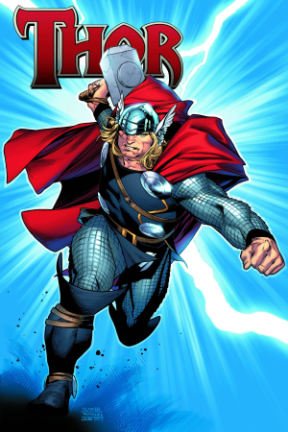 It’s difficult to think about Thor without the Kiss song “God of Thunder” reverberating inside my brain.
It’s difficult to think about Thor without the Kiss song “God of Thunder” reverberating inside my brain.“God of thunder and rock and roll
The spell you’re under
Will slowly rob you of your virgin soul.”
But I digress. As a comic connoisseur in my youth, I never connected with Marvel’s comic book version of the Norse God (despite the fact that I’m half Danish). Thor was dull: the stiff in the room (especially when compared to the wisecracking Spiderman and the snarky intensity of Ironman).
Thor spoke like a community theater actor channeling Hamlet. “Thee art my ally! Make peace!” Crap like that.
But I have a new appreciation for the Thunder God thanks to J. Michael Straczynski and Olivier Coipel. Thor – who was retired back in 2004 – is brought back to life in a new series as a rebel God – powerful, but brooding – with an angry, seething intensity that hides a broiling compassion for human beings and their troubles.
Gone, thank All-Mighty Odin – is the ridiculous dialog. Thor is given a new sleekier appearance (complete with blue chainmail armor) and a new attitude – and it works like a charm. Olivier’s version of Thor is youthful, but war weary. His illustrations are simply stunning. They may be the best part of the book.
But Straczynski’s storyline has Thor’s first order of business as rebuilding Asgard – the home of the Norse Gods. He makes the Oklahoma desert his base of operations and scans the world for his fellow Gods (although the highlight of Volume One is a crash-bang battle with Ironman). There’s lots of potential to be mined here, although knowledge of the Marvel universe is required as Straczynski does a poor job of providing an adequate back story for those fans reading Thor for the first time. But we’ll be back for Volume Two.
Grade: B+
The Immortal Iron Fist, Vol. 1: The Last Iron Fist Story
By Ed Brubaker, Matt Fraction, David Aja and Travel Foreman

First off, we love Matt Fraction – which is why we interviewed him a while back. Now that we’ve come clean on that:
Iron Fist was always a lame superhero; created by Marvel in response to the Bruce Lee craze in the 1970s. He wore the green pajama bottoms and appeared along side the more complex and always more interesting Luke Cage. Then he’d make rather pathetic guest appearances on Marvel Team-Up. He even died at some point – and then came back to life. Never liked him (and he was even a candidate for our list of lamest superheroes).
Thank Thor, we didn’t make that mistake, because the new series snap kicks major league butt. Iron Fist is finally given the back story that he deserves. In the new series, Iron Fist (Daniel Rand) is the latest of more than 66 Iron Fists than stretch back centuries – each generation getting their own version of the hero. The story introduces readers to Orson Randall, the previous Iron Fist, who broke his bond with the Iron Fist legacy and its leader K’un L’un and is living a life of drug addiction in Thailand.
A terrorist organization working for K’un L’un’s greatest emney – the Crane Mother and her champion, the murderous Steel Serpent, target Randall for death. Randall seeks out Daniel Rand and together they battle the enemy (and to say more would be a crime). But Volume One sets up a show down between Rand and Steel Serpent that is sure to shake the Marvel world to its foundations.
The artwork by Spanish illustrator David Aja using lots of dark inks – using shadows and light to effectively reveal character and give the new series a dark feel (most of the action takes place at night). His action sequences seem to move off the page and readers will find themselves wanting to practice swing kicks between chapters.
Here’s another graphic novel, however, that needs some background before plunging in. Novices to Iron Fist will probably find their heads spinning with all of the information.
Grade: B+
Batman: The Long Halloween
By Jeph Loeb and Tim Sale
 What do you get when you combine crime noir with a superhero comic? You get “The Long Halloween” – one of the most critically acclaimed graphic novels in the genre. Once you start – it’s near impossible to put down.
What do you get when you combine crime noir with a superhero comic? You get “The Long Halloween” – one of the most critically acclaimed graphic novels in the genre. Once you start – it’s near impossible to put down.Batman, a young Jim Gordan, and District Attorney Harvey Dent vow to bring down Mobster Godfather “The Roman.” But they are beaten to the punch by a mysterious serial killer dubbed “Holiday,” who begins to kill The Roman’s family and friends on each major holiday. Holiday kills them with a .22 and places trinkets representing the holiday near the dead bodies.
The story incorporates many of Batman’s most feared and popular villains – from the Joker to Poison Ivy. Even my favorite, Scarecrow, makes an appearance. There are great scenes between Batman and Catwoman – as they try to figure out if their animosity is real or just sexual foreplay.
But at the real center of story is the downfall of Harvey Dent, a respected and honorable DA. The graphic novel shows us his descent into cynicism and finally his transformation into the criminal psychopath Two Face.
The narrative expertly weaves the mystery – throwing up red herrings and giving us a wide range of possible suspects. Batman is a grizzled caped detective (think Mike Hammer in tights) – and one not unwilling to smack the bad guys around.
If you’ve always wanted to experience a graphic novel – then “The Long Halloween” is an excellent place to start. Action packed, compelling, and the art work is visually stunning.
Grade: A-
Best and Worst Superhero Movies
Blistering Barnacles: It's Tintin!
The Legends of Literature: Comic Books
Labels: Batman, book review, comics, Cracked-Back, Iron Fist, Thor
 StumbleUpon |
StumbleUpon |
 del.icio.us |
del.icio.us |
 Technorati |
Technorati |

This work is licensed under a Creative Commons Attribution-No Derivative Works 3.0 License.
The Template is generated via PsycHo and is Licensed.

